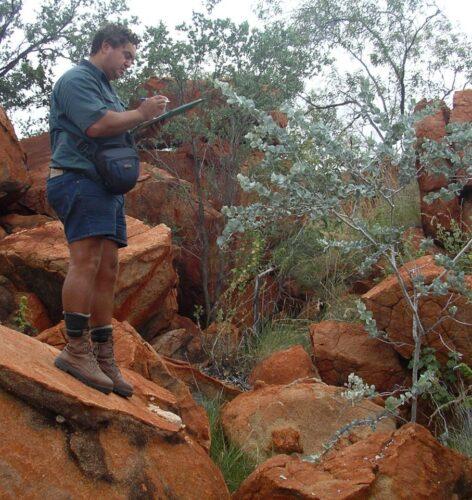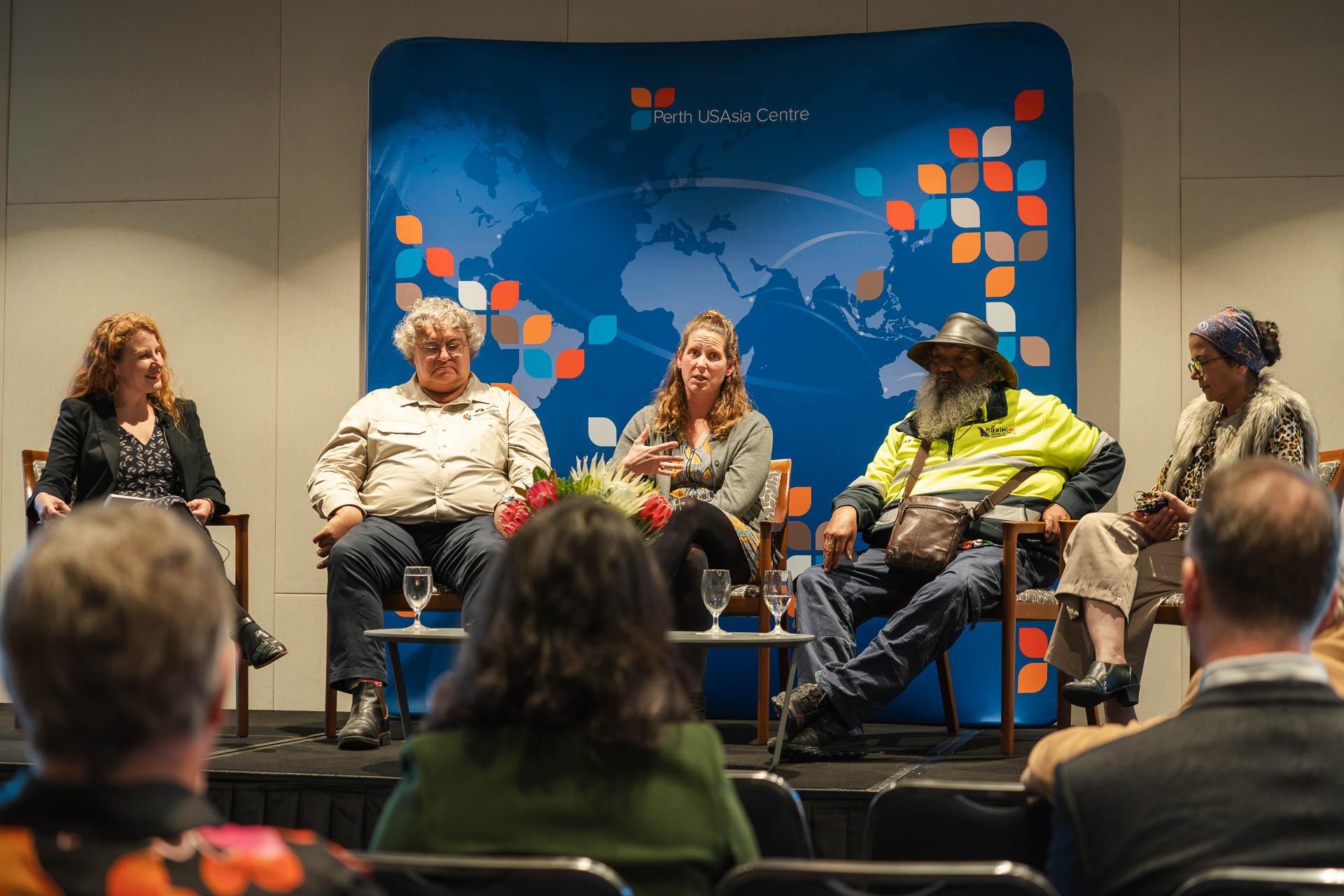11 July 2024
This week, Professor Stephen van Leeuwen and Teagan Shields spoke at the First Nations STEM Showcase, an event hosted by the Perth USAsia Centre for NAIDOC Week.
Stephen is our deputy hub leader and Teagan is a research fellow at the hub. They both spoke about what sparked their interest in science, their advice for First Nations scientists, and what keeps their fire burning.
On stage, Stephen and Teagan were joined by Leslie Schultz (Ngadju traditional custodian and Founder and Chair of Ngadju Conservation Aboriginal Corporation) and Humera Rind (Badimia-Yamatji woman from Midwest WA, and Manager of Indigenous Science Partnership at CSIRO).

Sarah Leary, Professor Stephen van Leeuwen and Teagan Shields on a panel for the First Nations STEM Showcase Event for NAIDOC Week 2024. Image: Alex Asbury.
“Australian Indigenous scientists … For 65,000 years, we were the first scientists, the first astronomers, the first aquaculture farmers – you go to Budj Bim area, where there are eel traps many thousands of years old. We were the first engineers: if you can pick up a stick, shape it, throw it and it returns to you, you’re a bloody good engineer! And mob were doing that a long time ago. It always comes up: how do we value Indigenous knowledge versus western science?”

Stephen during a Pilbara survey. Image: Kate Brown
For Stephen, a South West Boojarah Wardandi Noongar leader, his interest in science was fostered by his mother and by his father, who had a ‘mad passion for birds’.
“For the holidays, I’d disappear with my old man into the rangelands,” said Stephen.
When he wasn’t searching for birds, he’d go south to his mother’s country, fishing and gathering abalone at Injidup, Wyadup and other areas in the Leeuwen Naturalist National Park.
“Then, when I got into university, I had a great mentor, Professor Steve Hopper. He fostered my interest, particularly in plants, and that set me on my career in science.”
Stephen did his PhD at Curtin University, focusing on the reproductive biology of a rare species on Banksia, endemic to the Mt Lesueur National Park.
What followed for Stephen was many years in the Pilbara and the Western Desert. Stephen led the Pilbara biological survey from 2002–07. During this time, his team submitted nearly 8000 plant voucher specimens to the Western Australian Herbarium!
“For me, as a scientist it was great: for the first 5 or 6 years I was in the Pilbara, half my life was in the swag, collecting plants – and sometimes animals – that were new to western science. That was just fantastic, that was just mind-boggling – like going to Antarctica, or being an early explorer, Joseph Banks-style.”
“It really pushed me along and gave me great passion for documenting the biota out there, but also working on how we could get a better outcome and deliver something for mob – to put them back on Country.”
Stephen has now worked for 40 years across Western Australia. His work now focuses on building collaborative relationships with Traditional Owners and other land managers, so that there are enduring outcomes for biodiversity conservation, bio-cultural land management, and the stewardship of Country.
“We’re just starting to get to that point, at least in the research science space, where we’re asking people about their values, and how they want their lands, waters and sea Country looked after and managed. We’re starting to ask mob: how do you want to heal Country?”
With such a distinguished career, Stephen is now focusing on the next generation of First Nations scientists.
“[My work is now focused on] providing a pathway for mob into higher education. Let’s accredit rangers for the work they’re doing on Country. Through Curtin and NESP, we’re working towards opening up the pathway for Indigenous land managers and practitioners to find a way into higher education.
“For me, when I look at the two systems [Indigenous knowledge and western science], the disconnect is how it’s validated. You know, we think that just because something is published in a journal it makes it robust science. That’s probably not how I view it. There’s a huge pressure on Indigenous groups to validate their knowledge – and I think that that’s something that really needs to shift if we want to connect the two knowledge systems.”
Teagan Shields is a proud Arabana woman. She grew up on Awabakal Country, in Newcastle.
“Like Stephen I spent a lot of my childhood in the bush. My pop and my dad really taught me how to feel Country,” she said.
“So, we spent a lot of time running through the bush and the river and the beach and really understanding Country.”
“My twin brother and I were the first to finish high school in all of our family. My pop didn’t have a formal education, my dad finished around year 8 – so it was a big deal.”
After school, Teagan decided to study fisheries and aquaculture, through a Bachelor of Applied Science in Lismore in northern NSW. She then went on to study a Bachelor of Education and a Master of Marine Science and Management.
“I really enjoyed my Masters, that part of learning – it really inspired me. I thought, ‘I’m definitely going to be in this field, this is where I want to be.’”
A job came up on Wadjemup (Rottnest Island) in WA. It was a science communication position.
“I was really fortunate to be embraced by the Whadjuk community, and really nurtured in my growth. I was supported in my work to help recognise the really sad history on Wadjemup.”
 Teagan talks about her science journey. She was joined by Sarah Leary, Stephen van Leeuwen, Leslie Schultz and Humera Rind for the First Nations STEM Showcase. Image: Alex Asbury.
Teagan talks about her science journey. She was joined by Sarah Leary, Stephen van Leeuwen, Leslie Schultz and Humera Rind for the First Nations STEM Showcase. Image: Alex Asbury.
For the past 15 years, Teagan has worked in strategic policy reform, community engagement and biodiversity conservation across NSW, ACT and WA.
Through her own work and research, she has ‘an urge to prove to the western way of thinking that actually Indigenous knowledge is strong, and it has valid ways to conserve biodiversity’.
Teagan has just submitted her PhD. She is now working as a post-doc with Stephen on how to empower Indigenous land and sea managers through two projects through the hub and Curtin University. The Recognising culturally significant entities project and the Developing a National Indigenous Environmental Research Network.
When asked about what she’d say to young, aspiring First Nations scientists, Teagan is resolute.
“Look for the opportunities and embrace them. Always put your hand up for opportunities … you can always say no. But if you don’t put your hand up, you’ll never know!”
This article’s banner artwork is the NAIDOC Week poster ‘Urapun Muy’ by Deb Belyea, a Samuawgadhalgal artist from the Zenadth Kes (Torres Strait). ‘Urapun Muy’, from the Kalaw Kawaw Ya dialect of the Top Western Islands of the Torres Strait, means ‘One Fire’.
Want to know more about the Resilient Landscapes Hub's activities and our research into practical solutions to environmental problems? Stay informed about activities, research, publications, events and more through the Hub newsletter.
"*" indicates required fields